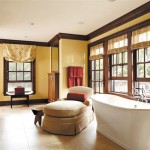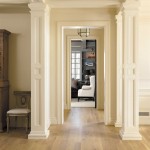A crowning moment
Carefully applied hard-wood mouldings and trimwork can transform a plain-Jane interior into an interesting and beautiful space.
The pros at the American Hardwood Information Center, www.Hardwoodinfo.com, and most design experts, recognize the following most basic categories of hardwood mouldings and trims:
• Baseboards, which run at the foot of walls and act as an elongated pedestal, are both aesthetic and practical. They visually anchor the wall to the floor and at the same time protect it from everyday low-impact abuse.
• Crown mouldings, which run between the walls and the ceiling, soften the abrupt transition between wall and ceiling.
• Casings, the trim surrounding door and window openings, define a wall opening and help connect the spaces being joined.
For architect Tim Button of Stedila Design, hard-wood mouldings are appropriate in any room in the home, but he also said, “I think wood trim often makes its biggest impact in an entry hall where high ceilings allow for large-scale crown mouldings.” And he’s a fan of using stained-wood mouldings in bathrooms, “because it brings warmth to what can be a somewhat clinical space.”
The size of the trimwork and the complexity of its profile will be determined by the size and style of the space in which it’s being installed; the larger and more traditional the room, the bigger and more ornate the trim.
Crown mouldings in particular have a profound and sometimes unexpected effect on how people perceive the scale, proportions and character of an interior, so they must be chosen with great care. If too small and plain, they’ll look skimpy and under-nourished; too large and ostentatious and they’ll overwhelm the space. If in doubt, consult a design professional.
Before the Civil War, American hardwood moulding was made by hand, so it tended to be expensive. In the later 19th Century, methods of mass production enabled builders to deck out even modest houses with affordable wood trim. The 20th Century saw emphasis on the inherent beauty of natural wood. This was followed by the Art Deco and Modernist movements, which further streamlined or completely eliminated mouldings and trims.
Today, tastes tend to be eclectic, and will depend on personal preference and the overall style of your home.
No matter what your architectural preferences might be, you can transform a plain-Jane interior into a distinctive, characterful environment by incorporating hardwood mouldings and trimwork into your home’s design.
This article is courtesy of Brandpoint.

